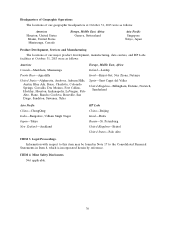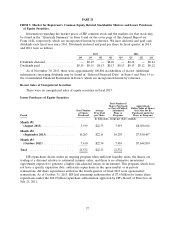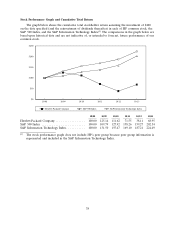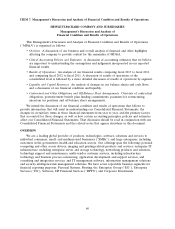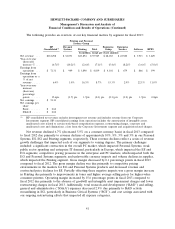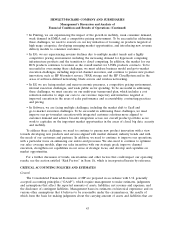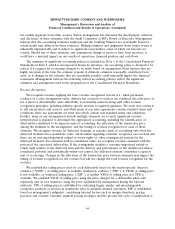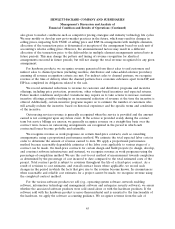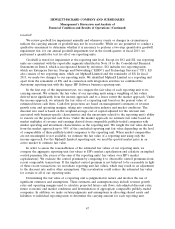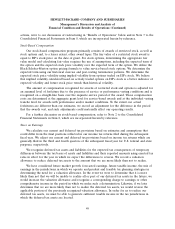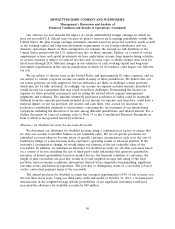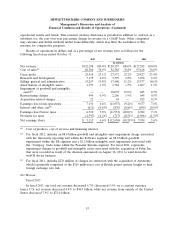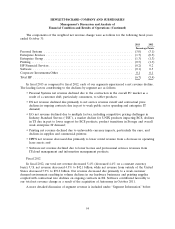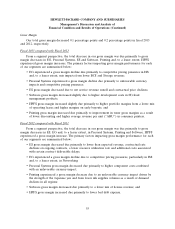HP 2013 Annual Report Download - page 53
Download and view the complete annual report
Please find page 53 of the 2013 HP annual report below. You can navigate through the pages in the report by either clicking on the pages listed below, or by using the keyword search tool below to find specific information within the annual report.HEWLETT-PACKARD COMPANY AND SUBSIDIARIES
Management’s Discussion and Analysis of
Financial Condition and Results of Operations (Continued)
also given to market conditions such as competitor pricing strategies and industry technology life cycles.
We may modify or develop new go-to-market practices in the future, which may result in changes in
selling prices, impacting both VSOE of selling price and ESP. In arrangements with multiple elements,
allocation of the transaction price is determined at inception of the arrangement based on each unit of
accounting’s relative selling price. However, the aforementioned factors may result in a different
allocation of the transaction price to the deliverables in multiple element arrangements entered into in
future periods. This may change the pattern and timing of revenue recognition for identical
arrangements executed in future periods, but will not change the total revenue recognized for any given
arrangement.
For hardware products, we recognize revenue generated from direct sales to end customers and
indirect sales to channel partners (including resellers, distributors and value-added solution providers)
assuming all revenue recognition criteria are met. For indirect sales to channel partners, we recognize
revenue at the time of delivery when the channel partners have economic substance apart from HP, and
HP has completed its obligations related to the sale.
We record estimated reductions to revenue for customer and distributor programs and incentive
offerings, including price protection, promotions, other volume-based incentives and expected returns.
Future market conditions and product transitions may require us to take actions to increase customer
incentive offerings, possibly resulting in an incremental reduction of revenue at the time the incentive is
offered. Additionally, certain incentive programs require us to estimate the number of customers who
will actually redeem the incentive, based on historical experience and the specific terms and conditions
of the incentive.
Outsourcing services revenue is generally recognized when the service is provided and the amount
earned is not contingent upon any future event. If the service is provided evenly during the contract
term but service billings are uneven, we generally recognize revenue on a straight-line basis over the
contract term. Losses on outsourcing arrangements are recognized in the period in which such
contractual losses become probable and estimable.
We recognize revenue as work progresses on certain fixed-price contracts, such as consulting
arrangements, using a proportional performance method. We estimate the total expected labor costs in
order to determine the amount of revenue earned to date. We apply a proportional performance
method because reasonably dependable estimates of the labor costs applicable to various stages of a
contract can be made. On fixed-price contracts for certain design and build projects (to design, develop,
and construct software infrastructure and systems), we recognize revenue as work progresses using the
percentage-of-completion method. We use the cost-to-cost method of measurement towards completion
as determined by the percentage of cost incurred to date compared to the total estimated costs of the
project. Total contract profit is subject to revisions throughout the life of a fixed-price contract. As a
result of revisions to cost estimates, and overall contract losses where applicable, we record such
changes in the period in which the facts that give rise to the revision become known. In circumstances
when reasonable and reliable cost estimates for a project cannot be made, we recognize revenue using
the completed contract method.
For the various software products we sell (e.g., operating system software, network enabling
software, information technology and management software and enterprise security software), we assess
whether the associated software products were sold stand alone or with the hardware products. If the
software sold with the hardware product is more-than-incidental and is essential to the functionality of
the hardware, we apply the software accounting guidance. We recognize revenue from the sale of
45



